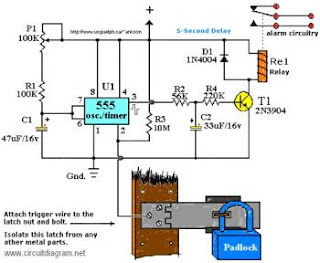This is a touch activated alarm system. Your alarm system will be activated when someone touching the "trigger". You may use this circuit at your home door, your vehicle etc.
Notes:
*The 555 can be a LM, NE, or MC(cmos) type, they're all pin-compatible.
**C1/C2's working voltage ought to be elevated to 25V in the event you decide to go with a 12V power source. Rule of thumb: the operating voltage of capacitors are at least double the supplied voltage, in other words, if the power source is 9 Volt, your capacitor(s) is a minimum of 18V. Transistor T1 could be any approximate substitute.
*** Use any appropriate relay for the project and if you're not tight on area, use any size. I've build this specific circuit to prevent students from fiddling using the security cameras in pc labs at the University I'm employed. I made sure the metal casing was not grounded. But as being the schematic shows you are able to essentially hook it as much as any type of metal surface. I utilized a 12-vdc power supply. Use any suitable relay to deal with your specifications. A 'RESET' switch (Normally Closed) can be added between the constructive and also the 'arrow-with-the-+'. The trigger (touch) wire is connected to pin 2 of the 555 and will trigger the relay, using the body resistance, when touched. It is apparent that the 'touching' component has to be clean and can make good contact using the trigger wire. This particular circuit might not be suitable for all applications. Just in case you wonder why pin 5 is not listed within the schematic diagram; it is not really required. In particular noisy circumstances a little ceramic capacitor is placed between pin 5 and ground. It will no harm to put one or leave it out.
Additional note: For those of you who didn't discover, there's an approximate 5-second delay build-in before activation of the relay to avoid false triggering, or perhaps a 'would-be' thief, and so on.
Circuit design by Tony van Roon.
 |
| Skema Rangkaian Alarm Sentuh |
Parts list:
| R1 = 100K R2 = 56K R3 = 10M R4 = 220K P1 = 100K D1 = 1N4004 | T1 = 2N3904, or equivalent U1 = 555 Timer* C1 = 47μF/16V** C2 = 33μF/16V** Re1 = Relay*** |
Notes:
*The 555 can be a LM, NE, or MC(cmos) type, they're all pin-compatible.
**C1/C2's working voltage ought to be elevated to 25V in the event you decide to go with a 12V power source. Rule of thumb: the operating voltage of capacitors are at least double the supplied voltage, in other words, if the power source is 9 Volt, your capacitor(s) is a minimum of 18V. Transistor T1 could be any approximate substitute.
*** Use any appropriate relay for the project and if you're not tight on area, use any size. I've build this specific circuit to prevent students from fiddling using the security cameras in pc labs at the University I'm employed. I made sure the metal casing was not grounded. But as being the schematic shows you are able to essentially hook it as much as any type of metal surface. I utilized a 12-vdc power supply. Use any suitable relay to deal with your specifications. A 'RESET' switch (Normally Closed) can be added between the constructive and also the 'arrow-with-the-+'. The trigger (touch) wire is connected to pin 2 of the 555 and will trigger the relay, using the body resistance, when touched. It is apparent that the 'touching' component has to be clean and can make good contact using the trigger wire. This particular circuit might not be suitable for all applications. Just in case you wonder why pin 5 is not listed within the schematic diagram; it is not really required. In particular noisy circumstances a little ceramic capacitor is placed between pin 5 and ground. It will no harm to put one or leave it out.
Additional note: For those of you who didn't discover, there's an approximate 5-second delay build-in before activation of the relay to avoid false triggering, or perhaps a 'would-be' thief, and so on.
Circuit design by Tony van Roon.